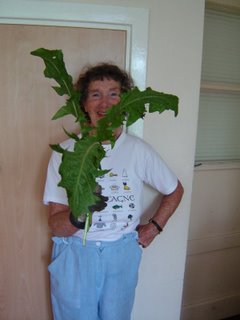The Lions of Mediaeval France
As I wrote a couple of days ago, the Communist calls any plant a dandelion.
He could well be right: apparently there are over a hundred species of them. They are closely related to chicory and have a bitter taste and diuretic properties. You can eat the young leaves in salad, should you wish to - but hey, I used to graze my way round the garden as a child eating anything edible, and I drew the line at dandelions.
Folk names include bitterwort, wild endive, priest's crown, doonheadclock, piss-a-bed, Irish daisy, blow ball, yellow gowan, puffball, clock flower, swine snout, Pu gong ying, fortune-teller, and cankerwort. All the books tell you it got the name of dandelion thus:
Two old French men were fruitlessly trying to dig them out of their lawns in about the year 1263AD, one Sunday afternoon, wishing that proper trowels and weedkiller had been invented.
"Eh bien," says Pierre, "quel plant is this?" (They lived near the coast and were fluent in Franglais)
"Vraiment, " replied Alain, "je ne sais pas. Je have never seen it before in ma vie."
"Regardez les leaves," said Pierre "Quoi does that look like to you?"
"Et alors," exclaimed Alain, "les leaves rassemblent exactement aux dents de lion."
"Oui," said Pierre excitedly. "Les dents de lion!"
And when Pierre went home to tell his wife that he had found a new plant with leaves that looked just like a lion's teeth, she was busy cooking some kind of vile mediaeval fish stew and didn't really listen so misheard the name and later told Mme Dupont next door that her husband had found a new plant called a dandelion.
Well, it's rubbish, isn't it? Firstly, Alain and Pierre had never seen a lion in their lives, not even on television, far less examined its teeth. Secondly, have you looked at a dandelion leaf? Okay, it is a kind of zig-zag, but tell me honestly, would you look at it and go "Wow! That looks EXACTLY like the teeth of that lion I saw at Longleat last August"?
No, I reckon somebody just made up the story to explain the word. I reckon the true explanation is that it comes from a long-forgotten Old English word meaning "nearly bloody impossible to dig out of the lawn."
The soil in our garden has been lovingly made from old vegetable peelings composted by my mother over a period of nearly fifty years. Add to this a bit of global warming and the dandelions are in heaven. Usually dandelion leaves are about six inches high, right? And occasionally up to a foot, in the right conditions.
He could well be right: apparently there are over a hundred species of them. They are closely related to chicory and have a bitter taste and diuretic properties. You can eat the young leaves in salad, should you wish to - but hey, I used to graze my way round the garden as a child eating anything edible, and I drew the line at dandelions.
Folk names include bitterwort, wild endive, priest's crown, doonheadclock, piss-a-bed, Irish daisy, blow ball, yellow gowan, puffball, clock flower, swine snout, Pu gong ying, fortune-teller, and cankerwort. All the books tell you it got the name of dandelion thus:
Two old French men were fruitlessly trying to dig them out of their lawns in about the year 1263AD, one Sunday afternoon, wishing that proper trowels and weedkiller had been invented.
"Eh bien," says Pierre, "quel plant is this?" (They lived near the coast and were fluent in Franglais)
"Vraiment, " replied Alain, "je ne sais pas. Je have never seen it before in ma vie."
"Regardez les leaves," said Pierre "Quoi does that look like to you?"
"Et alors," exclaimed Alain, "les leaves rassemblent exactement aux dents de lion."
"Oui," said Pierre excitedly. "Les dents de lion!"
And when Pierre went home to tell his wife that he had found a new plant with leaves that looked just like a lion's teeth, she was busy cooking some kind of vile mediaeval fish stew and didn't really listen so misheard the name and later told Mme Dupont next door that her husband had found a new plant called a dandelion.
Well, it's rubbish, isn't it? Firstly, Alain and Pierre had never seen a lion in their lives, not even on television, far less examined its teeth. Secondly, have you looked at a dandelion leaf? Okay, it is a kind of zig-zag, but tell me honestly, would you look at it and go "Wow! That looks EXACTLY like the teeth of that lion I saw at Longleat last August"?
No, I reckon somebody just made up the story to explain the word. I reckon the true explanation is that it comes from a long-forgotten Old English word meaning "nearly bloody impossible to dig out of the lawn."
The soil in our garden has been lovingly made from old vegetable peelings composted by my mother over a period of nearly fifty years. Add to this a bit of global warming and the dandelions are in heaven. Usually dandelion leaves are about six inches high, right? And occasionally up to a foot, in the right conditions.
Here is my mother with some she found this morning:

It would have to be a jolly big lion, that's all that I can say.

0 Comments:
Post a Comment
<< Home